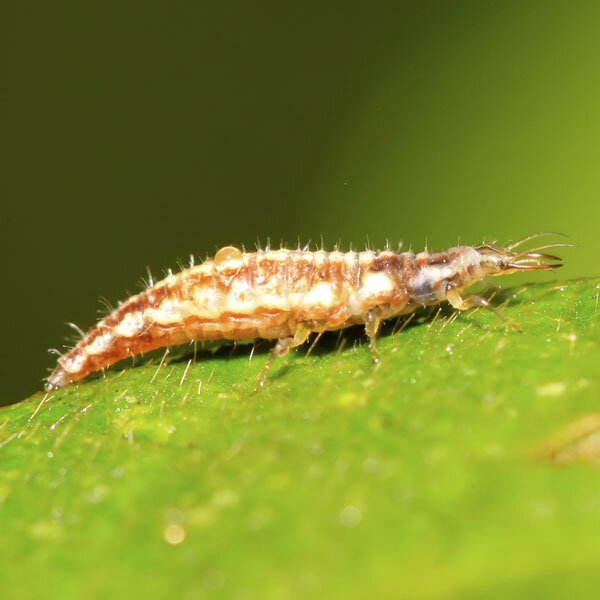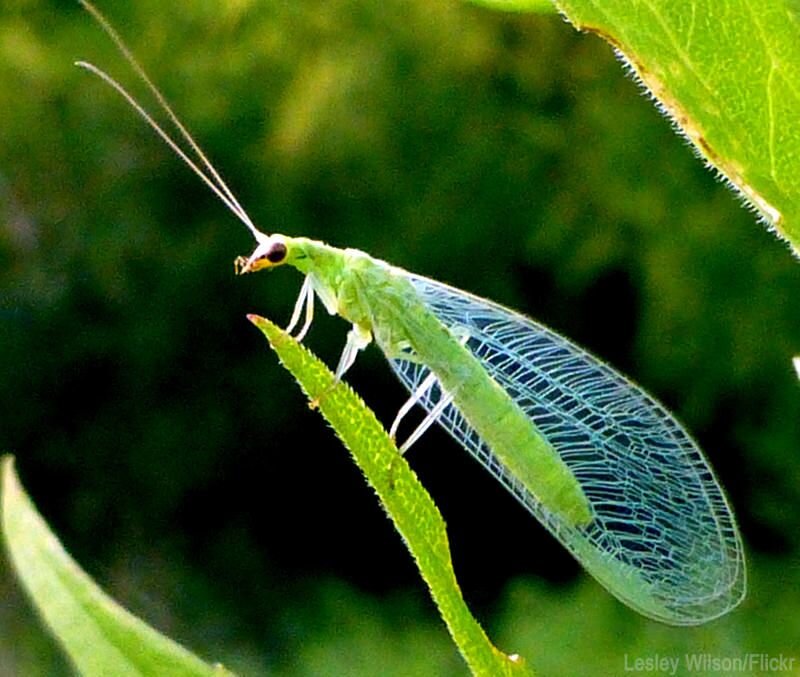Have you ever seen an adult green lacewing? Me either. They’re nocturnal! Adult green lacewings are active during the nighttime hours. Larvae can be active during the day and night.
Green lacewings are green or yellow colored, providing camouflage in areas of dense vegetation. As an under-appreciated group of beneficial insects, green lacewings are like lady beetles in that they are natural predators of many types of soft-bodied insects and insect eggs.
Green lacewings actively hunt aphids and mites and inject digestive juices into the body of the victim. In less than 90 seconds, a liquefied meal is ready to eat. While rare, lacewing larvae are known to bite humans. This is usually nothing more than a small skin irritation.
Green lacewings are small to medium-sized insects that belong to the group of net-winged insects. There are 1.300 to 2.000 species of green lacewings found all over the world. They inhabit areas with a temperate and tropical climate and are found in the fields, gardens, forests, tropical rainforests, and swamps.
SEX
Green lacewings undergo complete metamorphosis—egg, larva, chrysalis, and adult. On an average day, green lacewings are solitary creatures until it comes to procreate.
The “mating dance”, if you will, of the green lacewing wing is to produce a song of ultra-low frequency by vibrating their abdomens. During the spring and summer, courtship depends on the abdomen song.
EGGS
Photo Credit Nathalie Beauchamp
Female lays eggs 100 - 200 eggs in a lifetime. Like a monarch butterfly, green lacewings lay her eggs on the underside of leaves. And sadly these monarch eggs can become dinner for green lacewings. Overall, I like to think green lacewing larvae do more good than harm. It’s Nature’s way!
The eggs are either laid singly or in small groups. Each egg is always found perched on the tip of a hairlike stalk that is about 1/2 inch long. The purpose is to separate multiple eggs, to reduce the cannibalism of the eggs by sibling larvae.
Female green lacewings will typically deposit the egg close a food source for the emerging larvae, which can include any plant infested with aphids
Green lacewing eggs will typically metamorphize to the larvae stage anywhere between three and ten days, depending on the weather.
LARVAE
The green lacewing remains in the larvae stage from two to three weeks, and several instars later, then larvae enter the chrysalis stage. Each green lacewing larva will devour 200 or more pests a week during their two to three weeks developmental period.
The larva is elongated and light-colored with brown and grey stripes on the sides of the body.
CHRYSALIS
Five days later, a fully-formed adult insect emerges from the chrysalis. Some species of green lacewings overwinter in the pre-pupa stage, while others can overwinter as adults.
The chrysalis is light in color and egg-shaped.
ADULT
Green lacewings have golden eyes, long antennas, soft body, and two pairs of large, transparent wings, with green veins. Folded wings look like a tent above the body, and a wingspan of 2.3 to 2.5 inches, depending on the species.
The adult green lacewing is about 3/4 inch long, light green, and has a delicate appearance with lacy wings. One unusual characteristic is its eyes, they look like two golden hemispheres. Lacewings are weak fliers and are commonly found near aphid colonies. The adults feed mostly on nectar, pollen, and honeydew, but with some species, the adults will feed on insects.
Most species of green lacewings adults live around six weeks.
DIET
Green lacewings are omnivores; their diet is based on the plants and animals. In the larva stage, they feed exclusively on soft-bodied insects such as aphids, mites, flies, thrips, leafhoppers, caterpillars, and eggs of butterflies.
Adult green lacewings consume insects, nectar, and pollen, and also play an important role in the pollination of various plants, as they transfer pollen from one flower to another during feeding.
There are sources online to purchase these predators. And if you tried this approach with lady beetles only for them to fly away, you are in luck. Green lacewings aren’t agile flyers like the lady beetles, so they will stay in your garden.



